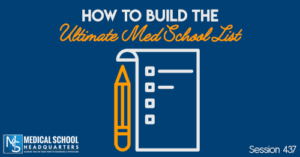Apple Podcasts | Google Podcasts
Session 437
Today, we talk about how to build a med school list. Our guest today is Joanne Snapp, former director of admissions at Hofstra Northwell School of Medicine and current director of the health professions advising office at UC Davis.
Listen to this podcast episode with the player above, or keep reading for the highlights and takeaway points.
In this episode, Joanne and I talk about different things in the premed process that we disagree on. We also have come to a mutual understanding that there is not one way to do this. There are many different ways and as long as you’re comfortable telling your story in whatever way that is, then great.
But there’s one thing that Joanne and I agree on – that the standard way students pick a school list is not very good. So we talk about how we recommend building a school list right now.
First off, The Premed Playbook: Guide to The Medical School Application Process is now available for pre-order!
When you preorder it, submit your receipts and we’ll get you a PDF copy of it so you can start honing your application. Avoid making mistakes as we see on the Application Renovation, which is my YouTube series where I review students who did not get into medical school.
For more podcast resources to help you with your medical school journey and beyond, check out Meded Media.
[03:28] Why Building a School List is Difficult for Students
There are a lot of misconceptions about how a school should be built.
The myth out there right now is that it really should be based around your metrics – your MCAT and your GPA.
And so, you have to be very reasonable about the schools you pick. If you’re in a very average range, you can’t fill your list full of Ivy League’s. However, there are tons of schools you can choose from. And
'If you're just using metrics to pick schools, you're missing out on a huge strategy.'Click To TweetThe MSAR is a tool that the AAMC has put out that houses all the medical school information. And it’s so easy for students to look into it and base their school list on the median MCAT and GPA for each school. They end up not looking at the mission and the vision. They don’t look at the fit, the location, or whether it’s public versus private. And so, they think the metics are the only thing that’s important.
[06:04] Why Fit is Super Important
'Most people have the mentality of just wanting to get in anywhere and that's another huge mistake.'Click To TweetIf you’re picking schools with a desperate mentality of you just want to get in anywhere, it’s not going to help you when it comes to strategically aligning who you are with the school.
When we talk about fit, think about the school’s curriculum model.
You should know every school you’re applying to whether it’s a PBL, or a case-based learning or a traditional model. And if you don’t know what those things are, please Google them and do some reading about those curriculum models. Because if you’re applying to a PBL school, there are really specific attributes that a PBL school is going to be measuring.
It’s also important to know whether a school is in an urban setting versus a school that serves a rural community. You want to know what communities are student run clinics. Every med school has a clinic, but who do they serve? What languages does that demographic speak? Do you speak that language? Can you serve that population?
Those are things you want to address in your secondary applications. Be able to tie in who you are and your attributes with the communities that the school serves, as well as their community service projects, clinics, and their hospitals.
You can Google the demographics of the city to see who predominantly goes to their clinics or hospitals.
[08:29] When Your MCAT is Below 500
Joanne says that every year, she sees a good chunk of students who have a 4.0 GPA and a 520 MCAT – and no acceptances. Then she also has people with 3.0 GPA and 503 MCAT who get two or three acceptances. That being said, the MCAT or GPA is definitely not going to get you in or keep you out. While it is important, it’s not that alone. It has nothing to do with whether you’re going to get into med school or not.
Now, if somebody has the below a 505, Joanne recommends that they split their applications between MD and DO because there are some DO schools that will screen at a 505 since MD and DO schools usually screen out a 505. But in terms of MD, there aren’t a lot of schools that will accept lower numbers. And you can use MSAR to a degree to filter those down in terms of the lowest 10%.
'You're still going to need to make a connection with that school, if you want to stand out with a 503.'Click To TweetYou’re going to really show them that you understand who they are, and you have to articulate why it is that you need to be there.
Keep in mind that you don’t need to validate the school and tell them how amazing they are. What they need to hear is why you’re good and what you can do for them. So if you’re coming in with lower numbers, you’ve really got to make a sales pitch about yourself about why you’re so valuable to them. And you can do that through that fit and how you could help them in their student-run clinics and community service projects, whatever it is that they have. What can you contribute to that effort?
[11:30] The Secondary Strategy
The secondary is where you are going to tailor every essay to each school. And that’s a lot of work. Creating your school list is a lot of work. But you can’t just copy the school list of other students. You have to do the research yourself.
Get deep into the websites and move past the admissions page. Go into the curriculum page and the Student Life page. Look at what the students look at when they’re med students and really find what it is about that school that they connect with.
If you can’t find a single thing about that school that you connect with, then you really shouldn’t be applying there.
There are enough schools out there to find one that has something you admire about it. And so you track that information on an Excel sheet. Then when you write your secondaries, you literally tailor every essay.
'You can share a lot of the content you use over and over. But whenever possible, tailor it to the school.' Click To TweetSay something really specific about every single school. Drop the name of the popular faculty member or the name of the clinic or the name of the population they serve. And don’t just list the names. Be sure to explain why they are important to you.
And then after your applications are complete and if they accept updates, you can send them interest emails. Again, articulate why it is that you want to be there. Joanne found over the years that those interest emails can be very effective at getting interviews.
[13:45] Don’t Look at the MSAR
The data that the MSAR gives are the median MCAT, median GPA, and then they have 25th to 75th percentile and 10th to 90th percentile.
My general recommendation is don’t look at any number. If you really have to, then look at that 10th percentile. Moreover, Joanne recommends not to look at the MSAR at all.
One thing that is useful about MSAR is they have this map that will show how many students from different states they accept. And if they don’t take anybody from your state then that might not be the best fit.
[15:44] How to Get in the Door of These Medical Schools
Especially now, buildings are literally closed. But you can reach out to schools, if they happen to be in a different region, and ask the school if they would be willing to have them in. Or if they have any alumni from their school if they’d be willing to meet with you. Joanne says this has been an effective strategy at least in getting in the door.
And if you can’t travel, just go to every source you can find. Go to the med school’s Facebook page, because it says a lot about what the school posts about. So if you go to their Facebook page, and everything is about the latest and greatest research, and they don’t post anything about their students, that says a lot.
You could also go to YouTube because students tend to be hilarious. And they make these funny, satirical videos that can sometimes be pretty revealing about the culture of an institution.
You might also want to be aware of the culture of the students that you’re going to school with. And so, just watching those kinds of videos gives you an idea.
[17:34] The Match List
One of the most common things lately has been the match list. Sometimes, there are people who want to go into primary care and that’s their top goal. And that’s really admirable. But historically, there have been people who have gone into primary care, not because they chose to, but because maybe they didn’t do so great on the boards. And so, primary care was sort of a backup plan, or last choice, because they didn’t perform well on the boards.
When a student says like 50% of their class goes into primary care, did they go into primary care because they wanted to, or did they get forced into primary care? That’s the first question.
And you can usually find that out by looking at whether they have any programs such as federal or state programs that pipeline people into primary care programs. If they do, that’s fantastic. If they don’t, and half of their class is ending up in primary care, look at where they’re matching. So are they matching top hospitals in the country like Brigham Young or UCSF? Or are they matching in the middle of nowhere with no name hospitals, which might be their top choice?
But if you see a school and you want to go into plastics, and you don’t see any plastic surgeon that matches, that doesn’t mean the school can’t produce plastic surgeons. It just means nobody in that class wanted to be a plastic surgeon.
So don’t make your decisions based on that. Instead, just look at the quality of the hospitals that the students are matching into if that matters to you.
'Don't look at the match list because the school doesn't make the match list – the students do.'Click To Tweet[21:03] Your Authenticity Comes Through
When you understand why you picked a school when you write the secondary, it’s going to sound authentic. And people who do that work are more successful. They get more interviews because the schools feel a connection back with you.
You need to be excited about the school you’re applying to. If you’re not excited when you apply, it’s going to come across as generic, watered down phrases.
“You really need to internalize why it is you want to be somewhere and you can't buy that from a formula. You can't get that off of some site. You need to do the work and really understand that.” Click To TweetIn addition, don’t pick a school just because your friends go there and they love it there. It’s a better idea to go into the cycle of understanding why you go to any of the schools on your list. And be happy with any of the schools because you did the work in understanding why you want to be there.
At the end of the day, you are going to be a doctor anywhere you go. But you want to make sure wherever you get accepted, you’re not going to be screaming and kicking your way there. You don’t want to go to med school regretting it and hating every minute. The worst thing you can do is get accepted and then not want to go and draw your application.
Joanne uses this roulette analogy where if you have ten $100 bills, where are you going to put your $100 bills? And you can say, you’ve always wanted to go to Stanford, that’s fine. You have 10 $100 bills, you can absolutely put that chip on Stanford, if you want. Well, what are the odds that it’s going to land on Stanford? Or you can put your $100 bill on a different place where there are a lot more options or a lot more possibilities.
So you can use the MSAR to narrow down the list. But if you don’t look up and figure out why you want to be there, then you wouldn’t know how to write your secondaries.
[26:51] Understanding the Yield Protection
Yield protection is a very interesting topic that a lot of students don’t really understand. Some students think it’s a way to unduly interfere with the admissions process.
Yield protection is the limited resource for medical school admissions of interview spots, which lead obviously to actual medical school seats. And medical schools need to be strategic with who they’re interviewing to make sure the people they’re interviewing are likely going to come to their school.
“Admissions offices have different screening processes for different people.”Click To TweetJoanne explains that admissions offices have different screening processes for different people. If you’re from the state that produces a lot of premeds, they will screen applicants from that state differently.
It’s the out-of-state students that don’t want to leave their state. So there’s a little bit of extra work you have to do for the out-of-state private schools.
The first assumption is you want a state school because it costs less, and nobody wants to move forward from home at that stage in life. So they’re going to interview you later, more than likely, unless you have super high stats. In which case, they know you might go to any school because they’re Ivy League.
Now, if you’re a middle range person, you have to do more work to convince them that you would actually go there. And that’s done through, again, the secondaries and through those interest emails.
[28:49] What to Do During Interviews
Once you’re invited to interview, you might find that you don’t get invited to interview at the out-of-state schools until January or February, at least after October 15, which is the first date that they can accept people. So they want to know if you are still interested after October 15.
Joanne recommends sending an interest email right after October 15 because that tells them you’re really interested in their school.
So after October 15, usually, they’ll open up more interviews. They’re more likely to waitlist out of state people. So it is your job to convince them how bad you want to be there.
'When you go to your interviews for out-of state-schools, you really have to compartmentalize.'Click To TweetEspecially if you have several interviews, you have to compartmentalize each interview and each school. Thoroughly convince yourself that you want to be at that school more than any other school in the country.
[30:31] Focus on Your Journey
Joanne reveals that another practice that happens is when schools don’t update their AMCAS records that they accepted somebody. That way, their acceptance rate looks much lower than it really is.
Try not to get sucked into that nonsense of the US News and World Report. Everybody looks at these schools thinking it’s so hard so it must be great. They play games and manipulate numbers.
Pick a school because you love it. Apply to it because you want to be there and tell them why you want to be there.
'Don't get sucked into all of the rankings and numbers and stats – that's just a bunch of noise in your head that you need to silence and just focus on your journey.'Click To Tweet[31:59] Final Thoughts
As you go through this process, start adding columns to that list and make sure that you’re tracking the same data for each school.
Start out with the basics – outstanding prereqs, letter requirements, location, and curriculum model.
And as you get better at searching, and you start to discover more things that you care about, your columns will increase, and you’ll start to differentiate schools.
Then submit at one school at a time and not submit every school at once. Use time and money strategically. That way, you’re not feeling that pressure. So just pace it out and conquer each secondary one at a time. That way, you can really focus on each school rather getting overwhelmed not knowing where to start.
Now, a better way than creating a sheet is by using Mappd. We actually have a team member right now scouring the internet to pull all that data into Mappd. We have a school list feature where you can add a school. Then you know the prereqs that you have and we know based on your contacts, who you have flagged for a letter of recommendation.












